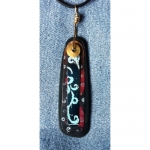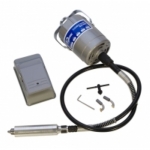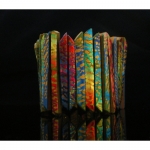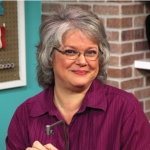2013 Instructor Interview - Meredith Arnold
Discover Mixed Media Jewelry Making with Meredith Arnold
Meredith Arnold describes herself as a "comedian artist," and when you meet her in-person, you'll find out why! Her subtle sense of humor comes through as she teaches and you'll love the no-pressure, easygoing nature of her class as you learns all kinds of amazing jewelry techniques and methods! Hailing from the Pacific Northwest, Meredith is greatly involved in the arts in her local community, and has been featured in books, magazines, and on the PBS show "Beads, Baubles, and Jewels," and she's also taught internationally. Taking a jewelry class with Meredith is opening up a whole new world of possibility!
Meredith sat down for an interview with Heather, our Classes Coordinator, to talk about her metal and polymer clay jewelry, and what her classes are going to be like in Tucson this February! Click below to listen in. Or, scroll down to read a complete transcript!
(audio not playing? click here)
You can get the next interview FREE by filling out this form:
Join us for 6 amazing interviews with internationally-renowned jewelry artists like Patti Bullard, Eva Sherman, and more. You'll love their insight, humor, and passion for jewelry-making!
Hint: You may be asked to confirm your email address after filling out this form. You will get the 2nd interview tomorrow. Please make sure customerservice@jewelrytools.com is added to your email addressbook or contacts list, because that will help our email get through to you!
Click below to explore Meredith's Classes this February in Tucson:
 Flame Painted Patinas Feb. 3, morning  |
 Discover the Flex Shaft 4 Chances to take this class: Feb. 3, afternoon  Feb. 4, afternoon  Feb. 5, morning  Feb. 5, afternoon  |
 Polymer Clay Tiles Bracelet Feb 4, morning  |
Transcript of our interview with Meredith Arnold
Meredith: I'm good, how are you?
Heather: I'm doing good, thanks. Let's kick off this interview: Tell me a little bit about what medium do you primarily work in?
Meredith: I primarily have worked in metal and polymer clay.
Heather: How did you find it? Was it the first thing you tried or was there a process of discovery and experimenting with other mediums first?
Meredith: I started as a fine arts painter, and I realized that I only thought in two dimensions, and I wanted to work and think in three dimensions, and that was intriguing to me. So I started working with beads and making jewelry, thinking, you know, small sculpture, and I ended up by trying a bunch of different things and ended up in polymer clay because I wanted to make my own focal point beads. There just wasn't anything out there that I liked, and boy it went away from there.
Heather: That's wonderful. What are the tools that you use most often?
Meredith: I use my Flexshaft tool a lot, I use a pasta machine, and wax carving tools a lot.
Heather: Have you ever improvised or repurposed a tool?
Meredith: Absolutely, all the time.
Heather: Tell me a little bit about that.
Meredith: When you work in polymer clay, you have infinite possibilities. You can actually make your own tools, and often if I'm stumped for a thing, I'll start making tools because that will just get my hands in it. And then I start getting the ideas of what to do next. I have taken big doll needles and made handles for them so that I have piercing tools. I have actually made cookie cutters so that I would have a uniform way to create the same shape again and again and again using metal stripping from a hobby store and JB Weld or 2-part epoxy. It just runs the entire gambit and if you look at my tools, you'll see a lot of them have handmade handles or they're from the thrift store. I've found things to suit my purpose… or from the kitchen! Haha!
Heather: What is your favorite way to finish a piece or your favorite effect?
Meredith: My favorite effect, at least in polymer clay specifically, would be using different kinds of foils. There's metal-gilding leaf and there's also a polyester t-shirt decorative foil; and mixing those two for some interesting complicated looking effects and my favorite finishing in metal is actually using the Flex shaft.
Heather: What advice would you give a beginner who may be intimidating by how intricate the process seems?
Meredith: You know, everything looks more complicated than it is. It seems to me that beginners look at the entire big picture first.
The reason why you take a class is you break it down to smaller portions, and so if you understand the sequence to break it down to, so that it's one step at a time rather than looking at the whole enchilada, then you're in better shape. And that's what classes are good for: the teacher has already broken it down for you and that makes it more chunks you can chew without choking.
Heather: Absolutely. Once you make a piece you are happy with, where does it go?
Meredith: Typically my work goes to galleries. Every once in a while, I like something so well I keep it for myself. I have a rule: I keep the first one, because the first one is never the best. It looks the best, but to get there, there are all kinds of mistakes made and so forth, then I never do things quite the same twice so everything is one of a kind, so that kind of blows that whole deal, but then it goes to a gallery so that's great.
Heather: What gives you inspiration to try new things, and what keeps you motivated?
Meredith: There is so much inspiration out there. Because I'm a mixed media artist and I primarily make jewelry, but I still do other things: I make books and I collage, teach glass fusing and all this other stuff, because of that I'm inspired by different patterns and colors and paper and fabric so I can leaf through a magazine (I'm like most people, they look at the pictures), and that'll spark new ideas and I'll start going off in my own direction or walk through a little bit of a fabric store or a paper/scrapbook store.
Then the other thing that inspires me a lot is tools. I think a lot of us just really love tools. I see a new tool or a tool that maybe I haven't seen before (new to me) and when I learn how it works it gives me a whole new idea of how to work and then I just start thinking about more work and that just keeps me going.
The other thing is teaching a class, I watch what my students are doing. I have my own ideas but my job is to teach when I'm in the classroom, and that is really hard because I have about 3,000 ideas in my head while I'm watching them, of how I might want to take something or do something, a new idea, and it is very inspiring to watch other people learn.
Heather: That's wonderful. Have you ever rescued a piece that seemed like it was broken and how did you do that?
Meredith: Absolutely. I actually get commissioned by a local jewelry store every once in a while a customer will come in with something that's missing a stone and they want me to replicate that in polymer clay, or it has a broken metal piece and it needs refabricating and so it's always a challenge.
The one thing about polymer clay is that you never throw it is away, it's never really broken because you can always fix it. It's just knowing how to repair the item, if it's polymer. With metal it depends on how the thing was fabricated to begin with, so that's where things can get a little tricky, a little complicated. I have made fake turquoise stones and fit them into a bracelet for a customer, and I've also resoldered a broken metal piece (a piece of copper tab and a clasp). I would like to repurpose them; if I wasn't doing something for a customer I would repurpose them. I might find another focal point to use it in a different way or sink it into polymer clay instead of what it was originally if it was a full metal piece.
Heather: So you're involved in art in your community. What's it like to encourage and help artists in your community succeed and how has that affected your own art?
Meredith: You know that's one of the most satisfying things that I do. I run a 55-hour professional development program for artists on business in the Seattle area. It is fabulous to see people taking off.
You know, it is just satisfying for your soul and I think that deep satisfaction, it's bone deep, makes me a better artist with my work because I'm very content in that realm of being of service, and at the same time it's in my chosen field which is art and jewelry. At the same time, I'm not working a day job I don't like and because of that everything I'm surrounded by is art related and artful and so it's very inspiring and it's very pleasing to see somebody who has just been able to put the puzzle pieces together and I see their names in galleries around the Seattle area and also around the country.
My former students, I have 80 of them that have run through that program now, and I see them everywhere I go, and they keep doing gangbusters and I keep in touch with all of them! Then in the classroom, people being able to launch off on their own, be independent and do what it is that they had in their head, that's a delightful thing. It makes me happy.
Heather: That is very wonderful that you do that. That's pretty impressive.
Meredith: And when I'm happy I make better work. Haha.
Heather: So you're teaching several classes in Tucson including classes about polymer clay and patinas. You're also teaching a class on how to use the Flexshaft tool. Can you tell me a little bit about how that tool is so helpful for jewelry artists.
Meredith: Yes. The Flexshaft tool, and I heard this when I was a beginner working in metal, somebody (a good friend) said "I wish I had started with this much sooner. It is the best thing I've ever picked up." It was another polymer clay artist. I thought that's weird, they work primarily in polymer clay and they were getting into metal.
It seems like a complicated, scary thing but actually that tool is, bar-none, one of the best things anybody making jewelry could pick up and learn how to use; because it saves you time, it saves your hands, it makes it so that the life of your ability to work is longer because you're being easier on your joints and your fingers. It also does things that would take you so long to do by hand and it actually expands the possibilities because you have the ability, like I said, to create finishes on the surface of metal that you might not originally have without a motorized rotary tool like that.
It cuts your sanding and polishing, everything, to 10% of the amount of time that it would have been if you would have done it all by hand. I can tell you this because I have done everything by hand up until not very long ago, so I know the difference! I'm at the point of where I need to save my hands, so it's forced me to use my Flexshaft more and I thought to myself, "Stupid girl, should've done that all along!" but I was a little intimidated like most people.
Heather: We're really excited to have you teach that class so that people don't have to go through that. You can give them first-hand experience.
Meredith: Yep. Shorten their learning curve.
Heather: What do you see most budding jewelry designers having the most challenge with?
Meredith: Two things: always finishing. I think that the difference between a hobbyist, and say, a professional, is in the finishing. If you really pay attention to have nicely-finished pieces, people notice. It's a tactile thing. If you buy a pin from somebody and your hair keeps getting caught in it, or it snags your clothes, you aren't going to want to wear, it so the finishing is important.
The other thing is the elements of design. I know everything comes back to the elements of design. Everybody thinks "Yeah, yeah, I've heard this all the time," but it really is important to keep your design skills up. I've been working in jewelry for decades and I'm still brushing up my design skills when I do collage; or work on my color skills when I do collage; or painting or making a book, whatever else I'm doing. I'm always learning about different color combinations and about how colors and textures can go together, and I think those things are really important, because that's how you develop your own style. That's the language that you have to use in a visual sense to develop your individual style. That's the most important thing.
Heather: Well thank you so much, Meredith. This has been an amazing interview and everybody needs to come take classes from Meredith in Tucson. She did teach with us last year and she is absolutely amazing, so don't miss out on this opportunity, not only to take a class from such a knowledgeable artist but such a genuine and fun person as well. Thanks so much Meredith, and thanks for your time.
Meredith: Thanks Heather.
Heather: Have a good one.
Meredith: You too.
You can get the next interview FREE by filling out this form:
Join us for 6 amazing interviews with internationally-renowned jewelry artists like Patti Bullard, Eva Sherman, and more. You'll love their insight, humor, and passion for jewelry-making!
 Flame Painted Patinas Feb. 3, morning  |
 Discover the Flex Shaft 4 Chances to take this class: Feb. 3, afternoon  Feb. 4, afternoon  Feb. 5, morning  Feb. 5, afternoon  |
 Polymer Clay Tiles Bracelet Feb 4, morning  |


 My Cart (Empty)
My Cart (Empty) 


